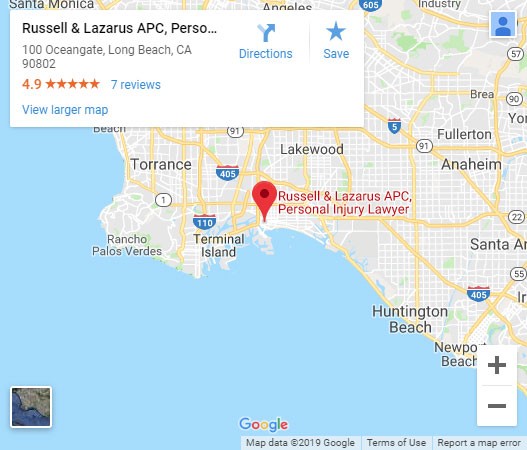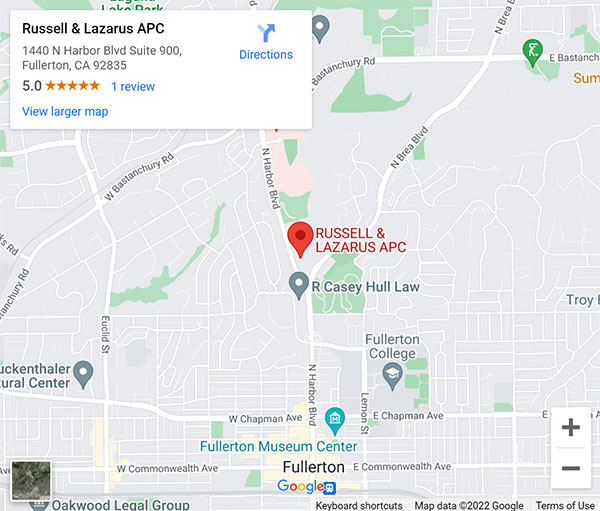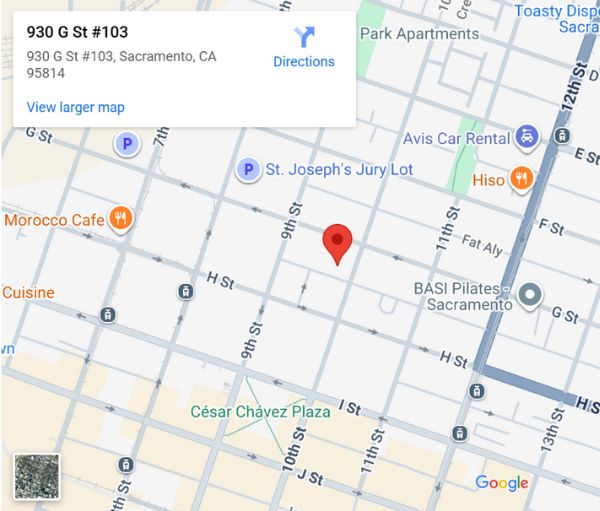Personal Injury Guide
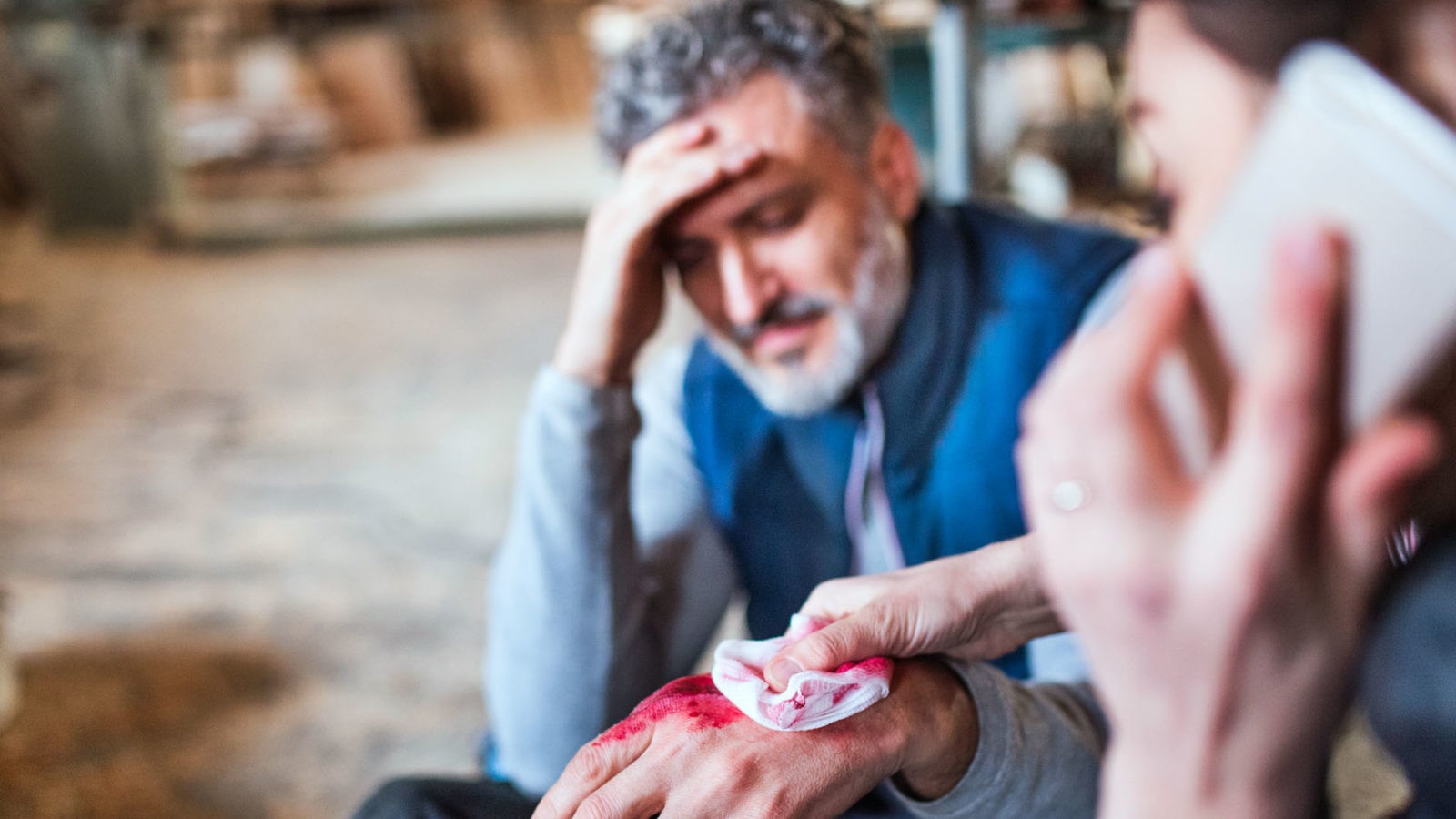
What Happens When You Are Injured Through No Fault of Your Own?
If you have been involved in an accident and are left with serious injuries—perhaps even injuries that could affect you for the rest of your life—it is important that you understand California’s personal injury laws. The best way to accomplish this is to speak to a knowledgeable Orange County personal injury attorney from Russell & Lazarus APC. Our attorneys work hard for our clients with a goal of ensuring they are properly compensated for the negligence of another. Hundreds of thousands of people across the nation are involved each year in accidents which result in serious injury: slip and falls in a public place, car collisions with a myriad of resulting injuries, medical malpractice injuries due to medical errors, injuries from a defective medical device or dangerous drug, and many, many more.
Most of us are totally unfamiliar with the legal system as well as unprepared for the level of paperwork required and the deadlines which must be met when a personal injury lawsuit is filed. Statutes of limitations must be considered, evidence gathered, witnesses consulted, and insurance companies dealt with. If you or a loved one has been seriously injured due to the negligence of another, it is likely you are doing your best to heal while carrying on with your everyday tasks. You may also be facing mountains of medical expenses, and, if you are unable to return to work, unpaid monthly expenses, as well. Trying to deal with a personal injury lawsuit on top of that can be overwhelming. The Russell & Lazarus APC attorneys can take that burden from you, handling all the legal issues with skill, experience, and compassion.
In most cases, in order to collect money following a personal injury in the state of California, you will be required to prove that the negligent party in your case failed their duty toward you, that the failure is directly related to your injuries and that you suffered damages as a result of that failure of duty. If your accident, caused by the negligence of another has left you with injuries which have significantly—or permanently—altered your life, if you have suffered significant levels of scarring or disfigurement if a loved one has lost his or her life due to negligence, if you are facing a never-ending level of expenses related to the accident, Russell & Lazarus APC can help.
What is Personal Injury?
When one person suffers harm from an accident with injury, and another person could be legally responsible for that harm, it is called a personal injury. The responsible person’s insurance typically pays the injured person for his or her medical expenses, lost wages, and pain and suffering associated with the accident. A personal injury can lead to a personal injury claim filed to collect compensation for the plaintiff’s injuries. While the vast majority of personal injury claims are settled out of court, some will go before a jury.
Before a personal injury claim is filed, the plaintiff’s attorney may try for an informal settlement. If the offer is sufficient to cover the plaintiff’s expenses related to the accident, then the settlement will take the form of a written agreement, signed by all parties involved. The plaintiff will agree to forego any further action against the defendant. When a formal lawsuit is filed, negotiations will take place all the way up to trial time. If the case simply cannot be settled, a jury will decide the case.
What are the Types of Personal Injury Claims?
There are many different types of personal injury claims, however, the most common personal injury claims include the following:
- Automobile Accident Claims (including motorcycle, truck, and pedestrian)—Auto accidents are more likely to lead to a personal injury claim than any other type of accident. When an auto accident occurs, there is usually one driver who is at fault—or mostly at fault. The driver could have been driving while overly fatigued, driving while impaired, driving while distracted, or driving recklessly or carelessly. When the at-fault driver causes an accident and subsequent injuries, his or her auto insurance could be responsible for paying those injured by the negligence. Auto accidents can lead to serious injuries, in some cases, lasing months, years, or even a lifetime. If you have been injured in an auto accident caused by the negligence of another, you will definitely want to consult an Orange County personal injury attorney.
- Catastrophic Injuries—Catastrophic injuries are those which permanently prevent an individual from performing gainful work or even performing regular day-to-day activities. A catastrophic injury leaves you with some level of permanent damage, often to the brain or spinal cord. Severe burns, loss of vision or hearing, amputation, and disfigurement are also considered catastrophic injuries. A catastrophic injury takes away a part of you, whether it is the ability to walk, the ability to think, or even the ability to go out into public without severe embarrassment (due to burns or disfigurement). Obviously, the more serious the injury, the greater the medical expenses. If you are left with catastrophic injuries, you could be forced to go through one or more types of rehabilitative therapy or could require permanent use of a medical device or medication.
- Brain Injury—A brain injury can be relatively minor (a slight concussion), or extremely serious. Brain injuries can alter your entire personality, causing severe cognitive and emotional difficulties. A traumatic brain injury can prevent you from ever returning to work, making it difficult to return to a “normal” life. Brain injuries can also result in hundreds of thousands of dollars in medical expenses. If you have a traumatic brain injury, you could require assistance for the remainder of your life.
- Spinal Cord Injuries—Like brain injuries, spinal cord injuries can alter the victim’s life forever. Motorcycle accidents, truck accidents, bicycle accidents, pedestrian accidents, and serious construction accidents can result in spinal cord injuries and traumatic brain injuries. Whether you are left partially paralyzed from the spinal cord injury or fully paralyzed, it is likely you will require assistance for your everyday life. A personal injury claim can help you recoup the expenses related to your spinal cord injury.
- Dog Bites—California is a strict liability dog bite state, meaning the owner of the dog is responsible if the victim is bitten in a public place or lawfully in a private place. Since a claim for dog bite injuries is considered a personal injury claim, you have two years after the bite to file a personal injury claim to preserve your rights.
- Slip and Fall Accidents—A slip and fall accident is considered a California premises liability accident. If your slip and fall accident was caused by the negligence of another, you may file a lawsuit to recover your damages, including medical expenses, lost wages, and pain and suffering. While most people are embarrassed to take a tumble in public, it is important that you are checked out medically after your fall, that you take photos of the area where you fell and the hazard which caused your fall, and that you contact an Orange County personal injury attorney as quickly as possible.
- Elder Abuse/Nursing Home Abuse—Finding out your loved one is the victim of elder abuse or nursing home abuse can send your world reeling. When you choose a home for your elderly loved one, you want to believe he or she will be safe and well-taken care of. Unfortunately, this is not always the case. Far too many elderly Americans are either directly abused—whether physically or mentally—or their basic needs are severely neglected. If you suspect your loved one has been abused, contact an experienced personal injury attorney immediately so you will know the best way to proceed.
- Construction Accidents—A study published by the California Division of Occupational Safety and Health found that in the state of California, construction accidents are the second-leading cause of death for workers. An average of at least one fatal construction accident occurred every single week in the five-year period between 2013 and 2017. While there are many causes of accidents on a construction site, the top four are falls, being struck by an object, electrocutions, and being caught in or between an object or machinery. A construction accident could be due to a lack of safety gear, unsafe working conditions, defective equipment, or third-party negligence, however, construction accidents usually cause serious injury or death. If you are the victim of a construction accident, contact an Orange County personal injury attorney who is experienced in construction accident claims.
- Product Liability Claims—When you use a product, take a prescription drug, or allow yourself to be implanted with a medical device, you assume the product was properly designed, properly manufactured, and has been thoroughly tested to ensure there are no problems. Unfortunately, this is not always the case, and hundreds of thousands of consumers are injured each year by a defectively designed or manufactured product.
- Other Types of Personal Injury Claims:
- Amusement Park Injuries—Emergency rooms saw nearly 30,000 injuries linked to amusement parks in 2016. People have even been killed on an amusement park ride, which was defective or improperly maintained. Unfortunately, there is a lack of data on amusement park injuries and death, with most statistics being taken from an annual safety survey. If you or your loved one suffered injuries from an amusement park ride or a slip and fall in an amusement park, it could be beneficial to speak to an Orange County personal injury attorney.
- Aviation Accidents—While aviation accidents are not especially common, when they do occur, death is usually the result. If your loved one died from a plane crash which was the result of negligence, you could be eligible to file a wrongful death claim and receive compensation for medical and funeral expenses. If the decedent was the primary breadwinner for the family, you may be entitled to compensation for the wages he or she would have earned over a lifetime.
- Boating Accidents—Californians reported 322 boating accidents in 2018. Thirty-four deaths resulted from those boating accidents. When a boating accident is the result of the negligence of another, you can file a personal injury claim, in the same way you would for an automobile accident caused by another person.
- Train Accidents—Like airplane accidents, train accidents are not all that common, but when a train accident occurs, it can cause catastrophic injury and death. Receiving compensation for a train accident can be complex, requiring a highly experienced Orange County personal injury attorney.
- Bicycle Accidents—The state of California led the nation in bicycle accident fatalities, with 338 cyclists killed in collisions with motor vehicles. Florida followed, with 329 cyclist fatalities. Six states—California, Florida, Illinois, Texas, Michigan, and New York—accounted for 54 percent of all bicycle traffic fatalities between 2010 and 2012. Like motorcyclists, bicyclists have nothing in the way of protection other than a helmet, so when they are hit by an automobile, the results are likely to be catastrophic or fatal.
How Does the California Statute of Limitations Affect Your Personal Injury Claim?
Statutes of limitations are laws put into place by each state which govern the amount of time you have in which to file your personal injury claim. These time limits can vary considerably from state to state, from six months to ten years or more. Missing these statutes of limitations can result in being forever barred from bringing a lawsuit against the negligent party. In the state of California, the statute of limitations for personal injury claims and wrongful death claims is two years from the date of the injury.
How is the Value of Your California Personal Injury Claim Calculated?
There are different categories of damages, or compensation, in personal injury claims, although in some cases, the categories may overlap. The categories of compensation include compensatory damages, which are further divided into actual economic damages and general, non-economic damages, and punitive damages.
Economic damages are intended to compensate you for specific monetary losses sustained from the accident. These can include lost wages, medical expenses, the cost of replacing or repairing damaged personal property, and, in a wrongful death claim, costs associated with the funeral. Medical expenses usually cover ambulance costs, hospital costs, physician costs, surgical costs, prescription medications, the cost of medical tests and treatments, rehabilitative therapies, and, in some cases, the cost associated with getting to and from the doctor or other health care professional.
Non-economic damages are harder to quantify. These damages are meant to compensate you for any losses which have resulted in a negative effect on your life, such as pain and suffering, loss of the marital relationship (loss of consortium), emotional distress, and loss of enjoyment of life. Perhaps you were involved in a traumatic car accident that left you in chronic pain, depressed, unable to sleep, and afraid to get into a car. If so, you might qualify for non-economic damages. When pain and suffering are claimed—and supported—insurance companies are more likely to settle the claim, knowing that juries tend to award significant settlements for pain and suffering.
Punitive damages are only awarded in cases where the behavior of the defendant was particularly egregious, reckless, or malicious. When a defendant behaved willfully or wantonly, punitive damages may be considered. Not only are punitive damages intended to punish the defendant, but they are also meant to deter the same type of behavior in others.
What are the California Laws Regarding Fault and Liability for a Personal Injury Claim?
In the state of California—as in all states—negligence must be proven in order to definitively show liability. Legal liability refers to whether the person who caused the accident had an obligation or responsibility to do—or refrain from doing—the thing that caused harm. The question may be asked as to whether the injury was “foreseeable.” As an example, if the owner of a dog which has bitten two other people lets the dog off its leash in a public place, is it foreseeable that the dog might bite another person? If a stack of boxes is left in the walkway of a grocery store, is it foreseeable that a customer might run into the boxes, fall down, and sustain an injury?
Along with foreseeability, comes reasonableness. In other words, we ask whether a reasonable human being, given the same set of circumstances, would have acted in the same manner. Foreseeability and reasonableness can be complex legal issues, often difficult to sort out. We then move on to negligence, which is an action or failure to act by a defendant who owes a duty of care to the plaintiff. The specific duty of care will depend on the relationship between the individuals involved.
As an example, the owner of a store has a duty to keep the premises clean and in relatively good condition with no obvious hazards or dangerous situations. A childcare provider or nursing home staff member has a duty to ensure the children or elderly are safe and healthy, an employer has a duty to provide a safe, hazard-free work environment, and a healthcare provider has a duty to patients to use a reasonably accepted standard of care to diagnose and treat. Product manufacturers have a duty to sell products that are designed correctly and free of defects, and drivers have a responsibility to follow the rules of the road and be mindful of others who share the road. The relationship between the parties is crucial to proving negligence.
Once it is established that the defendant had a specific duty to act—or not act—in a certain way, it must be determined whether the defendant breached that duty, whether that breach of duty caused injury to the plaintiff, whether the defendant should have foreseen the likelihood of that injury, and whether the injuries resulted in actual damages (medical expenses, lost wages, pain and suffering, etc.).
California’s comparative fault law must also be taken into consideration. If the plaintiff has some responsibility for his or her injury, that percentage of fault will affect the total amount of damages they can recover. As an example, if a restaurant left a spilled soda in the walkway for three hours, with no sign to indicate the hazard, and a person in the restaurant slipped and fell, the restaurant owner would be liable. If, however, the person was sending a text while walking, rather than watching out for where they were going, they might be judged to be partially responsible for the accident. Under comparative fault law, the amount of the award will be decreased by the percentage of fault assigned to the plaintiff.
What Types of Damages are Available in an Orange County Personal Injury Claim?
After you have been injured in an accident caused by the negligence of another person or entity, you may wonder how your claim will be evaluated, and what damages you can expect. There are factors that are more difficult to prove to an insurance company, including human loss. You may need family members and close friends to tell how the accident has affected your life to fully prove your damages. Once your attorney shows that another person was at fault for your injuries, you may be entitled to receive compensation for your losses, which could include:
- Medical expenses, past, current, and future;
- Lost wages from your job, including the time you were required to spend going to and from medical appointments, to pick up necessary prescription medications or to attend rehabilitative therapy sessions;
- Future lost wages;
- Property which was damaged due to the accident;
- Disfigurement or disability which was due to the accident;
- Costs associated with hiring another person to do the normal day-to-day chores you are generally responsible for;
- Your emotional distress which is directly tied to the accident, including anxiety and depression (pain and suffering);
- Any type of interference with your family relationships—known as loss of consortium, and
- All other costs resulting from your injury.
A personal injury attorney from Russell & Lazarus APC can help you determine what type of compensation you may be entitled to and can discuss ways to maximize your settlement based on your level of injury.
Can I Ask for Pain and Suffering Damages in My Orange County Personal Injury Claim?
Pain and suffering is a legal term referring to physical pain resulting from your injuries, but also to emotional and mental “injuries,” including the loss of enjoyment of life, trauma, fear, anxiety, stress, grief, insomnia, and inconvenience. Since it is so subjective, there are two methods generally used to place a dollar value on pain and suffering. The first method is to multiply your actual damages (medical bills and lost wages) by a specific number between one and five, which is dependent on the severity of your injuries.
As an example, if you were in a serious accident which left you with catastrophic injuries and the amount of your actual damages were $200,000, then that amount might be multiplied by 4, meaning the amount asked for pain and suffering could be $800,000. Of course, the defendant’s attorney will ask for a lower multiplier, and your attorney will ask for a higher one. Some attorneys prefer the “per diem” approach. This method assigns a specific number to every day, beginning from the day of your accident, and ending when you have reached maximum recovery. The number of days is then multiplied by the daily amount.
It is important to note that insurance companies may use neither of these methods, rather, they could use a computer program to determine the amount they should offer for your pain and suffering. You will need solid documentation to prove your pain and suffering in the form of photographs and personal journals that thoroughly detail your physical and emotional feelings. You may also have documentation from co-workers, friends, and family members to provide additional evidence of how the accident has affected your day-to-day life. If you seek treatment from a mental health professional, proof of that treatment will be required.
What Should I Do Immediately Following My Accident?
No matter what type of accident was responsible for your injuries, it is imperative that you be able to provide your Orange County personal injury attorney with enough evidence to prove your injuries were the result of the carelessness or negligence of another person. You will need to preserve all evidence to the fullest extent possible and should first always seek medical attention.
Even if you don’t think you are hurt very seriously, it can still be wise to let a doctor look you over. In many instances, the adrenaline rush you get at the time of the accident can mask symptoms. Neck, back, and head injuries, in particular, may not show up for days or even weeks. If you fail to see a doctor immediately, the insurance company may refuse to pay under the theory you were fine at the time, therefore, something else must have caused your current injuries. After you have attended to your health, there are certain things you can do which can immeasurably help your attorney in obtaining an equitable settlement for your injuries. These things include:
- If you are able, after your accident, write down every detail you can remember regarding the accident which caused your injuries. This can include weather conditions and the level of traffic if an auto accident was responsible for your injuries.
- If there were witnesses to your accident, gather as much contact information as possible, in the event your attorney needs to speak to them later. If you are too badly hurt to take photographs of the accident or obtain witness information, see if you can get a friend or family member to attend to these details.
- Always report your accident promptly to the police.
- Never, ever make a statement to an insurance company, or anyone else, before you have spoken to an Orange County personal injury attorney. Never admit fault, whether to the other person involved in your accident, an insurance company, the other person’s attorney, or the police. Let the police determine who was at fault.
How Will I Find a Personal Injury Lawyer in Orange County?
There are a number of ways to find the best personal injury lawyer in Orange County for your claim. You will want to find a top injury lawyer in Orange County—one with a proven track record of success. You may want to get some referrals before choosing your personal injury lawyer. These referrals can come from friends and family members, co-workers, an online Lawyer Directory, or from another attorney you are acquainted with. Once you have a list of names, you will want to set up consultations with several Orange County personal injury attorneys. You will discuss your claim and the potential ways it can be handled. (Most attorneys do not charge for this initial consultation).
During the consultation, you can ask each attorney how long he or she has been in practice, and what the lawyer’s personal injury specialty is. You will want to ask whether the attorney you are speaking to will actually handle your case, or if it will be handed off to associates (who might be less experienced). You will discuss your goals for your personal injury claim to see if those goals mesh with the attorney’s goals for your claim.
Finally, listen to your “gut.” Do you feel comfortable with the attorney? Can you easily talk to the attorney? Do you feel he or she truly cares about your personal injury and will fight on your behalf? Is this a person you feel you can trust? If you feel comfortable with the attorney and confident in his or her experience, skills, and ideas of how to proceed with your personal injury claim, you have likely found the best attorney to take your case.
What is the Timeline for My Orange County Personal Injury Claim?
It is entirely normal to wonder how long your Orange County personal injury claim will take; this can be an extremely difficult question to answer as the unique facts of your accident will come into play as far as your exact timeline. Generally speaking, if your claim goes to trial, it could take two years or longer to fully resolve. Below you will see how your Orange County personal injury case will progress, which will give you some idea of the time involved.
- Your first order of business is to obtain necessary medical treatment for your injuries. Your health is the most important issue to attend to, plus, if you do not see a physician for some time after the accident, it may be assumed that you couldn’t have been hurt as badly as you are claiming. It is equally important that you attend every single medical appointment and follow your doctor’s instructions to the letter. While this may not seem all that important at the time, it can make a huge difference in the success of your claim.
- Next, you will consult with an experienced Orange County personal injury attorney. Once you relay the facts of your case, your attorney will review your medical records, then will tell you whether you have a valid personal injury claim, giving you an idea of the compensation you may be entitled to. You will discuss a contingency fee arrangement with your attorney, signing an agreement for legal services.
- Your Orange County personal injury attorney will likely first attempt to negotiate a fair settlement on your behalf but will never accept a “lowball” offer.
- If a fair settlement is not offered, your attorney will file a personal injury lawsuit on your behalf. This lets the negligent party know you are serious about obtaining an equitable settlement and may result in a much better offer. The settlement negotiations can be in the form of informal discussions between your attorney and the defendant’s attorney or in the form of a formal demand letter, asking for a specific amount of compensation for your damages.
- The negotiations may go back and forth for a period of time; the insurance company will want to offer an amount which is well below the policy limits, and your attorney will want an amount that will fully cover all your damages, past, present, and future.
- Your attorney may secure expert opinions of those who can testify as to the extent of your injuries as well as the impact your injuries have had and will have on your everyday life and your ability to earn a living. These experts can be medical professionals, therapists, occupational therapists, or any other professionals who can back up your injury claims.
- If settlement negotiations are successful, a formal settlement agreement will be drafted. This agreement will thoroughly detail the terms of the compensation you will receive, releasing the defendant from any future liability related to the accident. All parties involved will sign the settlement agreement, which may then be filed with the court and approved by the judge who is overseeing the case.
- If settlement negotiations are not successful, your personal injury case will proceed through the standard California court process for civil claims.
- There will be a discovery process, which may include document requests, depositions, and interrogatories.
- Settlement negotiations will continue throughout preparations for trial.
- Mediation or another type of alternative dispute resolution may be ordered by the court.
- Most personal injury claims are resolved prior to trial, but if your case is not settled, it will go to trial, where a jury will hear all the evidence.
- If the jury finds the defendant liable for your injuries, they will award an amount of damages to you, then the court will enter a final judgment and award.
- The defendant has the right to appeal the judgment to a higher court; if the higher court reverses the first court’s decision, you will receive nothing, however, decisions are generally upheld.
- Because a trial is an all-or-nothing “win or lose” proposition, negotiating a settlement somewhere during this timeline is generally the best course of action.
How Can the Personal Injury Lawyers at Russell & Lazarus APC Help Me?
Once you have made the difficult decision to hire a personal injury attorney, you need to do your best to remove the focus from your (understandable) anger and frustration, asking yourself where you want to be once your personal injury claim has concluded. Identify your specific goals—such as having all your medical bills paid—then discuss those goals with your experienced Russell & Lazarus APC personal injury attorney. Our goal is to always be sensitive to your feelings regarding your personal injury claim while fighting hard to obtain a fair settlement for you.
While there are many good Orange County personal injury attorneys out there, we bring more than 25 years of experience to the table, along with an extremely high rate of success for our clients—95 percent. We have learned the successful tactics and strategies we use by fighting for clients just like you. We are tenacious in our goal of protecting the rights of our clients as well as ensuring they receive the maximum settlement possible. The Russell & Lazarus APC attorneys have a solid network of professionals who will help prove your personal injury claim.
When your case requires expert witnesses to testify on your behalf, we have those connections. Our attorneys work as a team because we believe that gives your case the very best chance possible. At Russell & Lazarus APC, our attorneys are intelligent, experienced, passionate, and aggressive, and we will “have your back” from start to finish. Contact Russell & Lazarus APC today—we promise to help you get your life back.
Locations
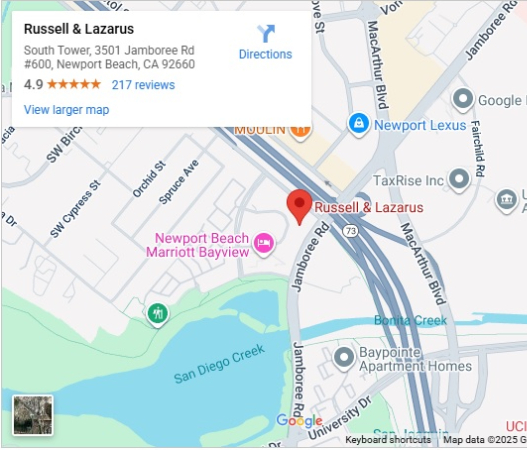
Phone: (949) 851-0222
Toll-Free: (877) 789-4878
South Tower, 3501 Jamboree Rd #600,
Newport Beach, CA 92660
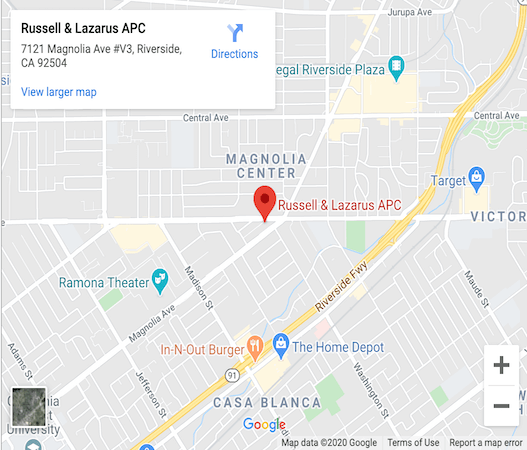
Phone: (951) 485-4000
Toll-Free: (877) 789-4878
Grandville Executive Suites
7121 Magnolia Ave., #V3
Riverside, CA 92504
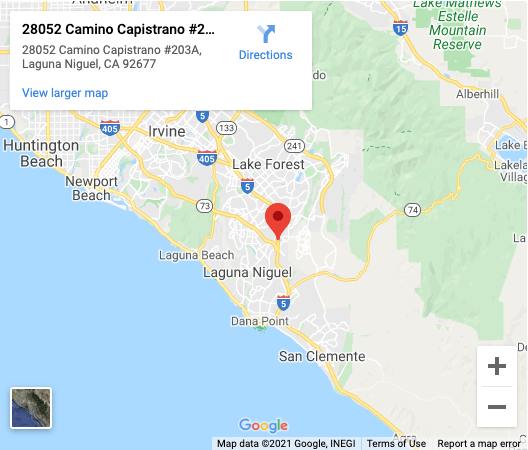
Phone: (949) 426-7299
Toll-Free: (877) 789-4878
28052 Camino Capistrano, Suite 203A
Laguna Niguel, CA 92677
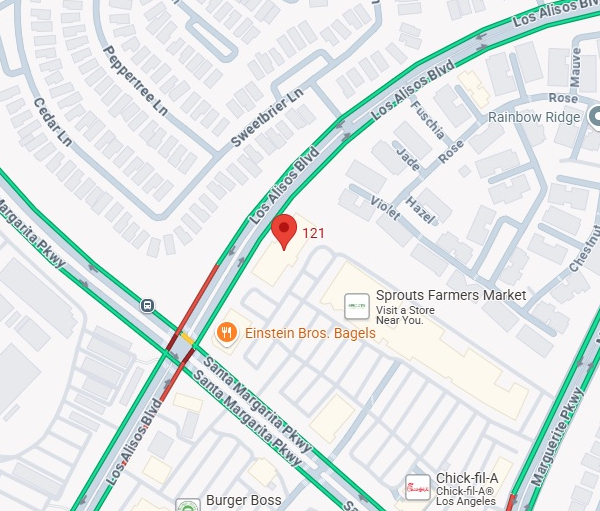
Phone: (949) 309-0990
Toll-Free: (877) 789-4878
27725 Santa Margarita Parkway, Suite 121 Mission Viejo, CA 92691

